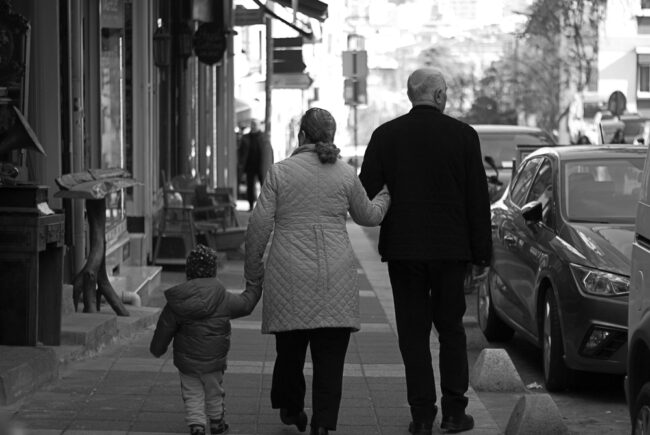

In many European countries, populations are ageing fast, and many generations of the same family are commonly all alive at the same time, yet intergenerational learning opportunities are often scarce. Photo: Shutterstock
In many European countries, populations are ageing fast, and many generations of the same family are commonly all alive at the same time, yet intergenerational learning opportunities are often scarce. Photo: Shutterstock
Intergenerational learning improves the participants’ well-being, strengthens communities and helps to solve complex issues. That’s why it has a bright future.
Intergenerational learning has been happening ever since one generation passed on the skills they had created to the next generation, explains Greg Mannion, a senior lecturer in education at the University of Stirling, Scotland, and author of the article “Intergenerational Education and Learning: We Are in a New Place”.
According to Mannion, intergenerational learning has also always been reciprocal. The younger generations continue to provide a welcome challenge to existing traditions, changing the practices created by the previous generations.
However, lately, this area of learning has been attracting more attention, as the potential and benefits of intergenerational interaction have become clearer: contact and learning among the different generations has been shown to empower all participants, nourishing intergenerational solidarity, and promoting inclusion and equality. Intergenerational learning also seems to be helpful when addressing complex societal issues such as climate change.
“Intergenerational learning and intergenerational education are certainly much more noticeable now in policy terms and in practice too,” says Mannion.
Creating space for intergenerational learning
In many European countries, populations are ageing fast, and many generations of the same family are commonly all alive at the same time, yet intergenerational learning opportunities are often scarce.
Mannion explains that we seem to have created a “generationally-niched way of life”.
“Care homes, early years education and care, schools and workplaces are some of the obvious places in which the generations are very separate. However, many of these contexts are seeking to create and offer new ‘shared-sites’ for multiple generations to learn from each other.”

Greg Mannion
Moreover, while family is still one space for intergenerational learning, family structures are small and people do not necessarily live close to their parents or other family members.
“It’s clear we need to provide contexts for encounters between generations outside the family. We can call this extra-familial intergenerational place a ‘shared site’.”
Intergenerational schooling is a new example of this kind of sharing and learning. There is now also interest and funding for developing intergenerational villages and reshaping city spaces too. Creating these shared sites is a multidisciplinary task.
“Designers, architects, learning programmers and landscapers are needed to help in this; it’s a big policy, research and development agenda.”
The conditions for intergenerational learning are generally planned and as such are created, meaning that they do not just happen
Bella Kerr, Intergenerational Development Officer at Generations Working Together, an organisation dedicated to intergenerational work in Scotland, also underlines the necessity of creating opportunities for intergenerational exchange.
Kerr recommends that, when planning any kind of projects or activities, it is good practice to involve different generations whenever possible. “The conditions for intergenerational learning are generally planned and as such are created, meaning that they do not just happen,” Kerr says.
Kerr hopes to see wider opportunities for intergenerational learning in the future, as part of formal, non-formal and informal education systems. “That way, all members of our societies can benefit from learning across their life spans.”

Bella Kerr
But do the spaces for intergenerational learning need to be physical? Not necessarily – at least if you ask Ad Geudens, one of the creators of the Belgian Parlangi language app. Geudens who is a former Dutch teacher himself, noticed that many retired language teachers missed teaching, felt useless and sought a solution that allowed them to keep on sharing their knowledge.
Through the app, those interested in learning a new language can connect to native speakers. The language learners are usually younger and the language mentors older. “One of the app’s missions is to connect different generations, which usually happens only in family between grandchildren and grandparents,” says Geudens.
An intergenerational approach can be applied to many areas
There are also particular areas of interest that have been brought up in the context of intergenerational learning, such as climate change. “If we look at climate change as an emergency that is happening now but has been caused by generations in the past and will be felt by generations to come, we can see how all issues around sustainability are intergenerational at their core,” Mannion says.
In order for solutions to emerge, it is necessary to create conditions for intergenerational learning. “Dialogue, mutual respect and opportunities for really meaningful shared encounters between members of different generations are needed. The role of Greta Thunberg in the climate action debate has brought intergenerational issues to the fore,” Mannion adds.
These starting points are also valid when discussing other problems. “Climate change reminds us that all issues we face as a society have an intergenerational aspect.”
Intergenerational learning programmes can assist in addressing demographic changes and create solidarity across the life cycle.
Through her work, Kerr has seen how intergenerational activity can address a wide range of issues and concerns such as inequality, social isolation and loneliness, and health and mental wellbeing.
“Using intergenerational learning programmes will strengthen social capital and bonds, creating social cohesion in our communities. It works well in combatting stereotypes such as ageism targeted at the young and old, can assist in addressing demographic changes and create solidarity across the life cycle,” she says.

Ad Geudens
In Parlangi, the intergenerational approach is completed by innovative language learning methods. As a teacher, Geudens was always trying to create opportunities to learn languages with native speakers, as he found the traditional methods of language learning very theoretical.
The meetings through the app aim at creating a chance to learn and teach language in an informal setting through conversation – the purpose is not to provide formal language lessons. The topics are chosen by the participants themselves, so language learning and intergenerational exchange become inseparable.
Keys for successful intergenerational work
Both Kerr and Mannion point out that intergenerational learning is much more than bringing different generations together to learn about each other.
Mannion underlines that it is important for efforts towards intergenerational exchange to include both intergenerational and educational dimensions.
“These efforts often seek to both address the goal of improved intergenerational relations and to address some wider issue or topic of concern together.”
Kerr adds that intergenerational work has far-reaching benefits that are not limited only to the participants.
“Intergenerational programmes are more than ‘feel good activities’. They mutually benefit participants, as well as volunteers, staff, family members, organisations and the community, and can address major concerns and issues in the local community.”
We want to connect people who usually wouldn’t connect, and show them that, regardless of skin colour or religion, we are all human beings.
She is currently working with the Scottish Soil Association’s Food for Life Project, which is an example of how intergenerational projects can benefit the participants, the community and the environment. The idea of the project is to bring people together around food in an intergenerational setting, thus building and strengthening communities. Sustainability both in terms of the environment and local economy are also present in the approach.
Parlangi, too, has a purpose that reaches further than bringing generations together in the context of language learning. Geudens also sees the app as a counterforce to the rise of the far-right and its consequences online such as trolling and other negative behaviours.
“We want to connect people who usually wouldn’t connect, and show them that, regardless of skin colour or religion, we are all human beings. There are people who want to talk to you and want to listen to you,” he says.
Author







